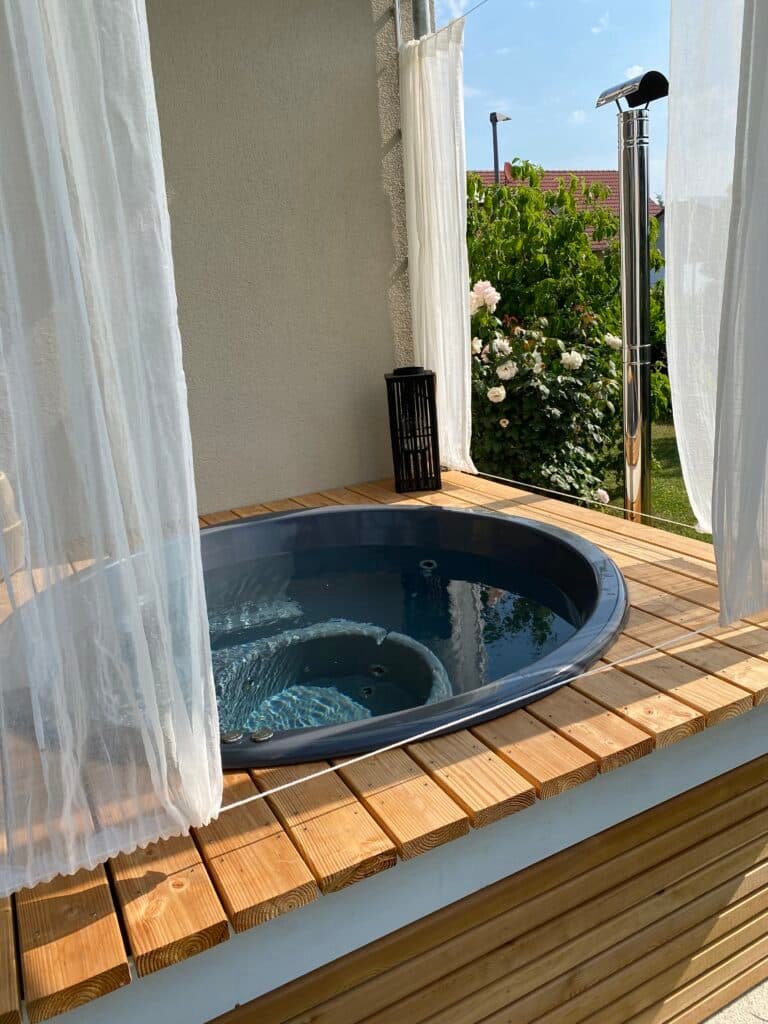Wood-fired hot tubs deliver a rustic spa feel with low running costs. Instead of electricity or gas, they use natural wood as the heat source—often cheaper and more sustainable over time.
Why wood-fired tubs are cost-effective
Their operating cost largely depends on the local price of firewood. If you have access to free or inexpensive wood—such as scrap pieces or fallen branches—the cost to run can be very low. Once heated, the water retains heat for hours, so you can enjoy a long soak without constant re-heating.

Warm-up time & the firing experience
Heating a wood-fired hot tub is a hands-on process. Expect roughly 2–3 hours to reach bathing temperature, as you manually start and tend the fire. Many owners enjoy this ritual as part of the overall experience.

Simple ways to lower running costs
- Improve insulation: Better insulation reduces heat loss and reheating. Learn more in our guide to thermal insulating outdoor hot tubs.
- Use a quality cover: A tight-fitting cover limits heat loss and evaporation. A solar cover by day can add free warmth from the sun.
- Stay on top of maintenance: Regular cleaning and care keep your tub efficient and long-lasting. See what to know before owning a hot tub and our eco-friendly hot tub tips.
- Plan your setup: A well-placed tub and thought-through utilities help day-to-day efficiency. Review required garden connections.
Bottom line
Compared with electric or gas models, wood-fired hot tubs are generally inexpensive to run, especially if wood is affordable locally. With strong heat retention and a few smart habits—insulation, covers, and routine care—you can keep operating costs low and enjoyment high.
FAQ: Wood-Fired Hot Tub Running Costs
Are wood-fired hot tubs expensive to run?
Typically, no. Costs depend on local wood prices. If you can source free or low-cost firewood, ongoing expenses can be minimal.
How long does it take to heat the water?
Plan for about 2–3 hours to reach a comfortable temperature, depending on conditions and firing.
How can I reduce ongoing costs?
Improve insulation, use a quality cover (and solar cover by day), and keep up regular maintenance. See our guides on insulation and eco-friendly practices.
Do wood-fired tubs hold heat well?
Yes. Once brought to temperature, they offer excellent heat retention so you can soak for hours without constant reheating.
What else should I plan before buying?
Think through base, access, and utilities. Start with what to know before owning a hot tub and required connections.
HowTo: Reduce Wood-Fired Hot Tub Running Costs
- Source affordable wood: Use inexpensive or responsibly gathered off-cuts where allowed.
- Add insulation: Improve tub and surroundings to limit heat loss. See insulation tips.
- Cover between uses: Fit a quality cover; add a solar cover by day to capture free warmth.
- Maintain regularly: Clean and care for components to keep heating efficient. Browse eco-friendly tips.
- Plan the setup: Ensure a sensible location and utility layout; review garden connections.

